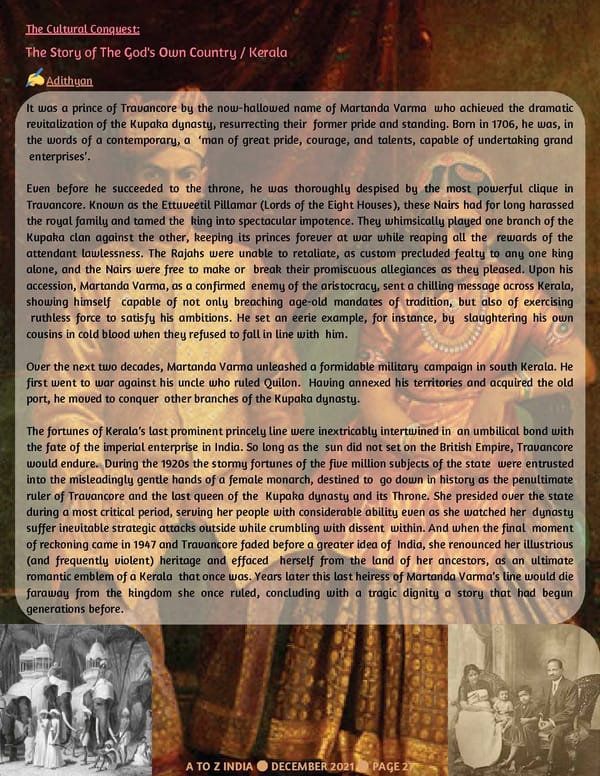Adithyan It was a prince of Travancore by the now-hallowed name of Martanda Varma who achieved the dramatic revitalization of the Kupaka dynasty, resurrecting their former pride and standing. Born in 1706, he was, in the words of a contemporary, a ‘man of great pride, courage, and talents, capable of undertaking grand enterprises’. Even before he succeeded to the throne, he was thoroughly despised by the most powerful clique in Travancore. Known as the Ettuveetil Pillamar (Lords of the Eight Houses), these Nairs had for long harassed the royal family and tamed the king into spectacular impotence. They whimsically played one branch of the Kupaka clan against the other, keeping its princes forever at war while reaping all the rewards of the attendant lawlessness. The Rajahs were unable to retaliate, as custom precluded fealty to any one king alone, and the Nairs were free to make or break their promiscuous allegiances as they pleased. Upon his accession, Martanda Varma, as a confirmed enemy of the aristocracy, sent a chilling message across Kerala, showing himself capable of not only breaching age-old mandates of tradition, but also of exercising ruthless force to satisfy his ambitions. He s et an eerie example, for instance, by slaughtering his own cousins in cold blood when they refused to fall in line with him. Over the next two decades, Martanda Varma unleashed a formidable military campaign in south Kerala. He first went to war against his uncle who ruled Quilon. Having annexed his territories and acquired the old port, he moved to conquer other branches of the Kupaka dynasty. T he fortunes of Kerala’s last prominent princely line were inextricably intertwined in an umbilical bond with the fate of the imperial enterprise in India. So long as the sun did not set on the British Empire, Travancore would endure. During the 1920s the stormy fortunes of the five million subjects of the state were entrusted into the misleadingly gentle hands of a female monarch, destined to go down in history as the penultimate ruler of Travancore and the last queen of the Kupaka dynasty and its Throne. She presided over the state during a most critical period, serving her people with considerable ability even as she watched her dynasty suffer inevitable strategic attacks outside while crumbling with dissent within. And when the final moment of reckoning came in 1947 and Travancore fade d before a greater idea of India, she renounced her illustrious (and frequently violent) heritage and effaced herself from the land of her ancestors, as an ultimate romantic emblem of a Kerala that once was. Years later this last heiress of Martanda Varma’s line would die faraway from the kingdom she once ruled, concluding with a tragic dignity a story that had begun generations before. The Story of The God's Own Country / Kerala The Cultural Conquest: A TO Z INDIA ● DECEMBER 2021 ● PAGE 27
 A TO Z INDIA - DECEMBER 2021 Page 26 Page 28
A TO Z INDIA - DECEMBER 2021 Page 26 Page 28